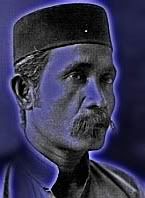Mat Sprong Ngilla Sapa Ddarak, III
Earlier episodes: I, II.
Ddarak macang-macang geröh buleh jjadi: nyiör buleh jatoh ddebök atah ppala bila dok tengöh jjalang, kaki buleh ssembak akör kayu, betis buleh ketik llipang atau patuk dulör, kalu kerengga, semuk gata tu mmalah nök kata je.
Bila bunyi seeeer! keluar dari belakang rök pohong kedudok ddalang gelak, suara kasör jereköh tubek tiba-tiba, lepah tu bbunyi pulök bising bbangör. Mat Sprong nnocak derah-derah dari tempat dia dok ccacang, seluör dia ngeccik sikik kena pacör.
“Ba’ape yang mung dök jjuruh sangak ning? Mung dök napök ke aku dok ccakong belakang ning?” Suara serök keluör dari balik pohong kedudok, hök daungnya kena ngeccik bau hacing pperök tu keluar sorang tua paka kaing batik lepah sela sepinggang; Mat cepak-cepak angkat balik zip seluör. Cik Kaleh suloh denge lampu picik.
“Eh, Pök Soh, mitök maaf bbanyök, ambe dök buleh tahang sangat takdi, dah ketek-ketek benör,” kata Mat.
“Mak, ddarak ning mung kena uting mmölek sikik, jangang dok pacör ikut dang je!” Pök Soh kilah kaing mmolek, muka penöh tanda tanya.
Mat ppaling ke Cik Kaleh. “Ninglah hök aku dok cerita kat mung tu, hök nama Pök Soh tu,” dia kata.
“Takdi aku dok derumöh kering mölek-mölek ada, keluör sekejak je, hujang dök ribot dök habih basöh jjerok!” Kata Pök Soh lagi, selamba.
“Mitök maaflah Pök Soh, ambe denge Leh ning mari nök jjupa Pök Soh jugök, nök tanya pasa ngilla tu.” jawak Mat, ssipu-sipu.
Pök Soh jjalang dulu balik ke rumöh, Mat denge Cik Kaleh ikut dari belakang, muka Cik Kaleh kkeruk sebab dök buleh tahang nök suka.
Sapa ttanga, Pök Soh ambek air dari ppayang, jiruh kaing ssahang dia. “Guana aku nak cerita kat bining aku ning, mesti dia tömöh aku kecing ttikör,” dia kata sambil dia retak kaing dia ke udara.
“Mung katalah, döh nök geröh, nök wak guane!” sapok Mat.
* * *
Cik Kaleh denge Mat dudok bbawöh lapu pang. Pök Soh keluör paka kaing baru, batik Wang Mang dari Ttanjong Pata. Dia bawök naik jari dia ke muka sambil kkeruk hidong; dia nasihat Mat: “Laing kali kalu mung nök kecing ddalang rök janganglah makang peta!”
Mat denge Cik kaleh dök tahang, terus suka kik-kik!; bini Pök Soh keluör dari belakang tabir. Pulok lepa, ggenang, tepong bukus ssusong atah pinggang, ttepi talang ada dua gelas kopi o.
Tiba-tiba dari ddalang gelak, jauh dari belöh matahari naik keluör bunyi hök buat Cik Kaleh naik seria.
“Oook, ook! Ooooooooooo....” bbunying lagi.
Mat Sprong döh ddebör dak-dak, tapi dia cuba wak dök je, tangang kanang dia pegang bungkus kecik lleher, azimat hök dia dapat dari Tok Bbageh masa di negeri Sekebong Bunga. Semangak dia naik sikik, mata dia dok keleh ke tepung bungkus denge kuih ggenang.
“Ggininglah Mak, “ kata Pök Soh. “Mung dengör bunying setang tu takdi. Tulah hök wak Mök Soh mung dök jjuruh aröh tu, tidor dök lelak, mandi dök basöh, makang pong dök, minung pong nök kata dök kena.”
Mök Soh lenggök ke atah, leher dia kkeduk, muka ceköng sebab kurang tidor. “Ggininglah kita le ning, bila lelak mata je bbunying setang tu dari belakang rök balik atah kubor tu.”
“Oook, ook! Ooooooooooo....” bunyi tu mari balik, macang orang gila dok ngilla, macang anjing lekak ccelöh pagör.
“Gi Soh, ambek kelepèr aku cceloh pitu tu,” kata Mök Soh ke laki dia. Pök Soh ikut selalu, dök banyök soal.
“Höh Mak, ambek ni, mung buak belanja,” kata Mök Soh.
“Dök payöh, natilah dulu,” kata Mat. Dia tarik tangang dari pitis hök Mök Soh hulor tu.
Bila dia tengök peranga Mat, Pök Soh ambek pitis tu dari tangang bini dia. “Ambeklah Mak, kang mung nök buat belanja dulu,” dia kata sambil tangang dia masuk kköcek seluör Mat. Pah tu dia ciung jari dia dua-tiga kali.
* * *
Jjalang balik Cik Kaleh göhek teksi dia ikut Jalang Paya Bunga, pötöng ikut Jalang Ceröng Lanjut, dök lalu ikut jerak Cina. Mat dok nnengung bbawöh hood, mata dia kelik-kelik dok ikut angang-angang di ppala.
“Ba’ape tadi mung Mak?” tanya Cik Kaleh bila teksi lalu bbawöh cahaya lapu kuning Jalang Pejabak Jang Besör.
“Ba’ape Leh?” jawab Mat, kkejut, bangung dari khayal.
“Takdi mung buak macang lebai, tak mboh pitis hök Mok Soh beri.”
“Kenalah ggitu, Leh. Kerja mata gelak ning dökleh lah buak löklak sangak, macang göhek teksi,” kata Mat. Cik Kaleh cerlöng sapa ppinör mata.
Kemudiang dia ccakak balik. “Mak, takdi aku tengök jalor kaing Pök Soh tu.”
Mat dök kata apa. Mata dia dok sölör bayang-bayang balik pohong ru.
“Aku tengök jalor patat kaing hök kena kecing mung tu, ada tiga jalor kuning, dua ija, tiga kuning,” kata Cik Kaleh.
“Apa kena ngenne denge apa-apa ni, Leh?” tanya Mat.
“Döklah, aku ingak mölek nombor tu kalu aku gi tikang ekör.”
Noteh: Cerita ning rekaang semata-mata. Kalu ada orang atau tepak hök sama macang ddalang ning, tu kebetolang je.
Labels: Cik Kaleh, Mat Sprong

